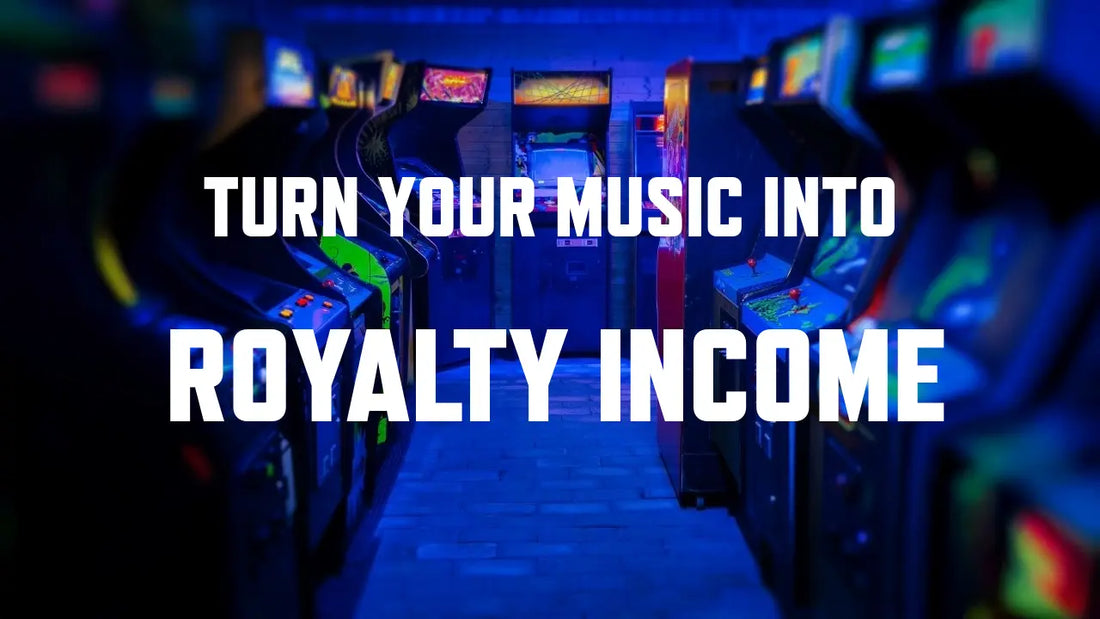
Scoring Games in 2025? Here’s How to Turn Your Music Into Royalty Income
Share
If you're a composer, producer, or artist looking to make money from licensing your music, you've likely heard of sync fees and royalties. But most creators—especially those new to the sync world—aren’t quite sure how it all works behind the scenes.
Who pays? When do you get paid? How much can you actually make? And what’s the difference between a sync fee and backend royalties?
This guide will break it all down—clearly and practically—so you understand exactly what’s at stake when your music is used in film, TV, games, ads, or digital media.
And if you’re a video game composer, we’ll show you why understanding royalties can turn your one-time gig into a long-term income stream.
🎬 What Is a Sync License?
When someone wants to use your music in a visual project—whether it’s a Netflix show, a YouTube ad, or a mobile game—they must acquire a synchronization license (aka a sync license). This gives them the legal right to synchronize your music to their visuals.
A sync license is a one-time, upfront payment that covers:
- The master recording (the actual audio file)
- The composition (melody, lyrics, arrangement)
If you own both (aka one-stop), the deal is cleaner and faster.
Example: An indie film wants to use your instrumental track in a montage. You agree to a sync license for $1,000 upfront. That’s your sync fee.
But here’s the part most newcomers miss: that’s just the beginning.
💰 Sync Fees vs. Royalties
1. Sync Fee = Upfront Payment
- One-time fee negotiated at the time of placement.
- Paid by the production company, brand, or content creator.
- Ranges wildly: from $200 (small YouTube use) to $10,000+ (TV ad) to $50,000+ (national campaigns or major trailers).
Example: You license a track to a car commercial for $5,000. That’s your sync fee—paid once, often before or shortly after the ad airs.
2. Performance Royalties = Backend Payouts
- Paid after the fact by performance rights organizations (PROs) like ASCAP, BMI, SESAC (U.S.) or PRS (UK).
- Triggered when your music is broadcast or streamed publicly—on TV, radio, streaming services, or even in public venues.
- These are collected and paid quarterly, and they can stack for years.
Example: That same car commercial airs nationally 300 times on network TV. Each broadcast triggers a royalty payout via your PRO. You might earn $1,500–$3,000 extra just from those broadcasts—even months later.
🕹️ Royalties for Video Game Composers: What’s Possible?
Traditionally, most game composers worked on a buyout model—you get paid a flat fee for composing the score, and that’s it.
But today’s ecosystem is changing. With:
- Live-streamed games (Twitch, YouTube Gaming)
- Mobile ads
- In-game events and licensed DLC content
- Game soundtracks released to DSPs (Spotify, Apple Music, etc.)
- Cross-media usage (trailers, TV spots, YouTube recaps)
—composers now have more ways than ever to earn royalties beyond their initial fee.
🎮 Example: Indie Game Soundtrack Royalties
Let’s say you compose 10 tracks for a narrative indie game. You negotiate a modest upfront fee—say, $4,000 total. But you retain:
- Publishing rights to your compositions
- The right to release the soundtrack on Spotify
- A clause that gives you royalties if the music is used in marketing content
What happens:
- The trailer with your music hits YouTube and racks up 3 million views
- The game goes viral and gets reviewed on IGN, which uses your theme
- You release the soundtrack independently on Spotify and it generates 500k streams
Over 6–12 months, you might collect:
- $1,000+ in performance royalties from international airings
- $1,500+ in streaming royalties from Spotify/Apple Music
- Exposure that leads to three new sync offers for other projects
💡 The key? Don’t sell your rights unless the price is worth it.
🎤 Other Royalties and Revenue Sources
✅ Mechanical Royalties
- Triggered when your music is reproduced—digitally or physically (like downloads, CDs, or vinyl).
- For video games, this may apply if your music is part of an OST sold separately.
✅ Streaming Royalties
- If your music is released as part of a soundtrack and streamed, you’ll earn Spotify/Apple Music royalties via your distributor (DistroKid, CD Baby, etc.).
✅ Micro-Sync (YouTube, Instagram, TikTok)
-
Short-form uses often pay smaller fees, but they can drive reach, lead to more placements, and—when monetized—create passive revenue.
🧠 What You Should Always Track
- Your PRO registration info (are your works registered correctly?)
- Your writer and publisher splits (do you own 100% or have collaborators?)
- Where and how your music is used (to ensure royalties are reported)
- Any library or agency contracts (are they collecting on your behalf?)
- Whether the deal is exclusive or non-exclusive
📌 Track every placement and register every cue—it’s the only way to collect everything you’re owed.
- 🚀 Final Thoughts: Royalties Aren’t Passive—They’re Leverage
- Sync royalties aren’t just nice to have. They’re what turn your catalog into a compoundable revenue stream. For composers—especially in fast-moving industries like games, trailers, and content marketing—royalties are a way to:
- Earn long after the job is done
- Increase your total value per track
- Build a career that doesn’t rely only on upfront gigs
If you want a music career that lasts, you need to understand your royalty rights. And if you're a game composer, licensing-savvy decisions today can pay off for years to come.
Want help monetizing your catalog or negotiating smarter licensing terms?
🎧 Work with Playbutton Media — we help composers and producers unlock long-term revenue from sync, games, and beyond.
